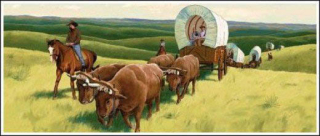In 2015 I was talking with a friend in America about family history. He said that there is no family history back beyond his great grandfather Clarence Monroe Barnes, because Clarence’s father had died when Clarence was young and there was no oral history. My reply was that oral history isn’t needed, that you simply follow the paper trail. And promptly set myself the challenge to do so.
The only American family history research I’d conducted before then was from 1891 onward, based in Philadelphia, in the city where immigrants arrived from England and Wales and generally stayed or moved to the industrial areas of Pennsylvania.
But with the Barnes family, I’ve been tracing a family who originated in North Carolina, were farmers and who travelled west before the time of roads and railways, seeking new homes and land. I’m grateful to Jack for giving me his family details and permission to follow the family trail, in this case, the wagon trail.
They travelled before the introduction of the Vital Records of births, marriages and deaths and so, compared with English records, the paper trail has been more limited than I expected. As an experienced family historian who prides herself on practising safe genealogy, by which I mean genealogy which is supported by fact, the shortcomings of the paper trail take me out of my natural comfort zone.
When the Vital Records aren’t available and we are working from the early censuses and documents, we have no choice but to study everything, and I emphatically mean everything, and try to reason out who the people were, where they came from, where they went to. It is perfectly okay to do this as long as we do not try to pretend that something is fact when it is only reasoned conjecture. Unfortunately I have frequently been frustrated by the many inconsistencies and clear errors in other peoples’ research.
I am happy with the research and information which I present in this document, back to the time of Clarence’s great grandfather, Wright Barnes and his children born between 1820 and 1838. My attempts to pursue Wright’s origins have led to many hours of research, many pages of notes covering the period 1700 to 1830 and several possible family members, including at least one in the Revolutionary War. But, frustratingly, the vital link to connect them has proved to be very elusive.
I have spent hours going round and round in circles, as if I am in the midst of the children’s game, standing blindfolded in the middle whilst all the possible characters in Wright’s early life dance around me, keeping just out of reach. However, I do not give up easily and I will keep searching, hoping to write a final chapter of Clarence’s family history some day.
In this account I have tried to explain every step of my research and how I have arrived at my conclusions. I hope what I’ve written is clear, even though it may take a few readings to get the full sense of it. To make matters clearer, there is some repetition between sections, such as showing relevant census details pertaining to several people. If you have any queries, .
I hope what follows is of interest to members of the Barnes family who will forgive an English family historian delving into their family history. I hope you will enjoy the journey as we travel back in time.
Image from: http://jy3502.hubpages.com/hub/The-Old-West-Wagon-Trains#
